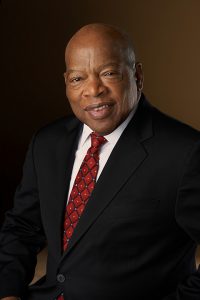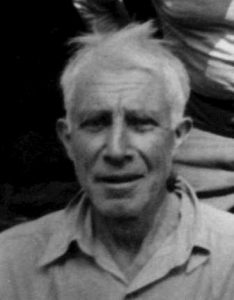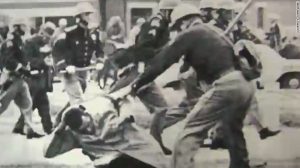Peace Train: Congressman John Lewis, the Legacy of Nonviolent Resistance, & Richard Gregg
John Wooding, professor emeritus of political science at UMass Lowell, is the author of the forthcoming biography Gandhi’s American Friend: Richard Bartlett Gregg (Loom Press, October 2020). He is a past contributor to this blog and president of the board at Mill City Grows in Lowell.
‘Cause I’m on the edge of darkness
There rides the Peace Train
Oh, Peace Train take this country
Come take me home again
–Cat Stevens
U.S. Representative John Lewis (Web photo courtesy of J.D. Scott)
I met John Lewis once. Something you don’t forget. University of Massachusetts, Lowell, Commencement in 2007. It was a cold, blustery, wet June day in the Lowell Spinners’ baseball park. The stage was over at third base and the audience hunkered down behind home plate under a sea of blue umbrellas, too far away to do anyone much good. It was a brief shake of the hand. I was too intimidated to say much, looking at a living legend. I mumbled something like “It’s an honor . . . thank you for coming.” Not exactly words for the ages. He was shorter than I thought he’d be, but looked younger than I imagined. He gave his speech, but it was hard to hear as I was sitting behind him and the sound system was losing the play against the weather. But I got some of it. It was, of course, stirring. And surprisingly funny. I didn’t expect that. Why would I? This is the man who had been beaten and arrested many times for doing what was right for, as he memorably put it that day, “getting in the way.” It takes a special person to see any humor in that.
Congressman John Lewis at UMass Lowell Commencement (Web photo courtesy UMass Lowell).
I hadn’t thought much about that day until now. But with his death I was reminded of that moment and my inauspicious welcome to an icon of the Civil Rights movement. Reminded, too, that this was the man who stood and took a beating on that bridge in Selma, Alabama, and didn’t hit back. Can you believe in something that much? But I get it now. Some thirteen years have passed, and I have just finished writing about the life of Richard Bartlett Gregg, the American pacifist. Most people have never heard of him, even those who can reel off the names of the greats of Civil Rights: Lewis, King, Bayard Rustin, Rosa Parks, A. Philip Randolph, and all the heroes from the Freedom Rides, the Student Nonviolent Coordinating Committee (SNCC), Montgomery, and the March on Washington. These are the people and the moments that changed America. They did it with nonviolent resistance. Where did that come from?
Pacifism has a long history and lots of connections to nearly all the world’s religions. Our desire for peace knows few boundaries of time or place, or of profession. The peace train has had many riders: Leo Tolstoy, Albert Einstein, Jeanette Rankin, Benjamin Spock, Martin Luther King, Jr. and, of course, Gandhi. How did these connect and come together? How did this history frame the courage of John Lewis?
Richard Bartlett Gregg (Web photo courtesy RichardGregg.org).
Part of the answer lies with Richard Gregg, one of the first Americans to live and study with Gandhi in the late ‘20s and the author of the Power of Non Violence, the book that shook up the world of pacifists in the 1930s. He was vital in transmitting Gandhi’s ideas about social, economic, and political change into a western context. Gregg provided the strategic and tactical value of nonviolence by recognizing and advocating for nonviolent resistance as a performance, one that informed and educated the audience. He emphasized that violence is inevitable, but can be combated by acts of moral “jiu-jitsu.” For Gregg, the nonviolence and good will of the victim of violence act in the same way that the lack of physical opposition by the user of physical jiu-jitsu does, causing the attacker to lose their moral balance.
The horrific images of Lewis and others being beaten by cops and not resisting had an enormous moral and political power. But to do this takes courage and training, and a profound belief in the righteousness of one’s cause, and faith in the beloved community. Gregg knew this and, like his mentor, Gandhi, recognized that people could be trained to be effective nonviolent resistors in much the same way that the military trains warriors. This was very controversial, even among pacifists, and brought a whole new dynamic that lifted the actions of pacifists out of the moral universe (and, indeed, the moral high ground) by advocating direct nonviolent action rather than “thoughts and prayers.”
Young John Lewis in light raincoat being beaten by an officer at the Edmund Pettus Bridge during a march to support voting rights in Alabama in 1965. (Web photo courtesy of cnn.com)
Active adoption of nonviolent resistance can be traced back to the Congress of Racial Equality (CORE), founded in 1942, and the most important vector for bringing Gregg’s work into the Civil Rights movement. In the 1940s, the group used anti-segregation sit-ins at restaurants and movie houses across the South—which put into action the principles of nonviolent resistance. CORE’s founder, George Houser, had read Gregg, and the key players in CORE were colleagues of Gregg’s who sought his advice. Their acts and ideas came to influence the perspective of key groups in the South in the mid-’50s. These influences would coalesce quickly as the nonviolent strategy of the Civil Rights movement, especially in the critical moment of the Montgomery bus boycott, even though the leaders in Montgomery were not themselves pacifists.
The original activists of the bus boycott were fighting for racial equality but had not been, for the most part, conscientious objectors during the war. Indeed, many of the Southern activists were armed and ready to fight. It was the efforts of people such as Bayard Rustin and George Smiley and, later, many of Lewis’s comrades in SNCC, who convinced Martin Luther King, Jr. that nonviolence was not only the Christian way, it was also a smart political strategy.
Gregg’s work helped train Civil Rights activists in SNCC, stressing nonviolent resistance as theater. SNCC’s early newsletters listed The Power of Non Violence as the most important book for participants to read, placing it above King’s Stride Towards Freedom. Later, King would fully promote and adopt its ideas. When Gregg sent King a copy of his book in 1956, King wrote back, “I don’t know when I have read anything that has given the idea of nonviolence a more realistic and depthful interpretation. I assure you that it will be a lasting influence on my life.” King wrote the foreword to the 1959 edition of Gregg’s book. While there is no doubt that King had already been aware of Gandhi’s thinking, it was Gregg’s work that placed it in a context that more closely fit what would become King’s strategy for the Civil Rights struggle. King’s commitment to nonviolent resistance in the Civil Rights struggle came, in no small part, from his reading and contact with Gregg.
Like King and Lewis, Gregg argued that violent resistance to domination or change through war or revolution would create more violence and more domination—that the means would define the end. Gregg believed a genuinely nonviolent society can only be achieved through peaceful means. For Gregg as for Gandhi, truth and nonviolence are the basis from which all other efforts to reduce violence must be built. And this truth is also about personal self-knowledge and the conduct of one’s self in all activities, and at all times.
Gregg lived a life that reflected his beliefs. He was a gardener and philosopher—turning the soil was, in part, the equivalent of changing society—a slow, deliberate process that would reap rewards in the future. To get to this point, Gregg knew that understanding of the self could best be achieved through collective self-government, participatory democracy, and a process of group decision-making in a nonviolent culture and form. In this, Gregg was essentially arguing for a deep commitment to what we would now call sustainable practices and ecologically sound activities as part of participatory, local democracy. While Gregg was never at the barricades, he influenced key activists by conceptualizing practices and ideas that showed the way to a peaceful and just society. But it took John Lewis and others like him to put these into practice at the barricades.
Had I known all this on that wet June day I might have been able to say something intelligent to Lewis. But now I know that the peace train that he was on was pulled by history, ideas, and the writing of some great thinkers. This is why history is important, why knowing is important, and why we should never forget the utter bravery and remarkable life of the son of Alabama sharecroppers.




Beautiful tribute for John Lewis. I’m sure nothing would please the great man more than to have his tale linked to the peace train and to remind us that we can all choose to get on board or take the train heading to our oblivion. Thrilled to hear that John Wooding’s biography of Richard Gregg will be available on Loom Press in October. Can’t wait to get my copy.
Old memories are being freshened up with the sad news of this weekend. We are constantly reminded of those great people, men and women who reshaped our world. I remember when John Lewis was a household name, it isn’t hard. Even after the biggest fights and struggles of the civil rights movement were done, he kept fighting for justice. Richard Gregg thank you for keeping these memories alive.
John Lewis UMass Lowell Commencement Address, June 2, 2007 https://www.youtube.com/watch?v=Lpmo5b6_Abk
Beautiful, John. I look forward to reading the book.
Thanks for this tribute.
Who doesn’t love John Lewis! A great human being, who like we don’t see often.
Thank you John. This is a wonderful tribute to both Lewis and Gregg. I look forward to the book with great interest.
This is an outstanding testimony to these two brilliant exponents of nonviolent theory and practice. John Wooding’s biography of Richard Gregg comes as a perfect complement to the new edition of Gregg’s “The Power of Nonviolence” edited and with a scholarly introduction by the eminent Canadian philosopher, James Tully. These two books should give Gregg’s stellar achievement the recognition it deserves. No time in our history could be more relevant and urgent to study and apply nonviolent action. Thanks for this excellent article. If it’s any consolation then I confess that I met John Lewis only once and also missed my opportunity to articulate my reverence for him. This splendid essay should offer some consolation.
My thanks to you all for these kinds comments. I hope we can get Gregg the recognition he deserves. The biography should be available this fall.
In the meantime, I heartedly recommend James Tully’s collection of Gregg’s writing in the Power of Non-Violence. The introductory essay by James is essential reading for anyone who wants to know more about Gregg’s contribution to pacifist thought.
My memories of Richard Gregg (“Uncle Richard” to me) go back
to the 1930’s when the Bemis-Gregg family celebrated Christmas and Thanksgiving at the Bemises in Chestnut Hill.
I remember Uncle Richard as kindly, soft spoken and gentle in every way. Later in the 1960’s and 70’s my son Alan Day was inspired by Uncle Richard and travel to Oregon to visit with him and Eleanor.
He also went to Maine (was it Sargentville or Bucksport) Where he camped out and spent time with Scott Nearing and Uncle Richard.
My relationship with Uncle Richard grew with correspondence and an occasional visit. He sent me several of his books and wrote about his thoughts.
God keep you, dear Uncle Richard. You have left us with inspiration to travel the road of Peace and to have profound understanding of non violence and love. Ann Bemis Day